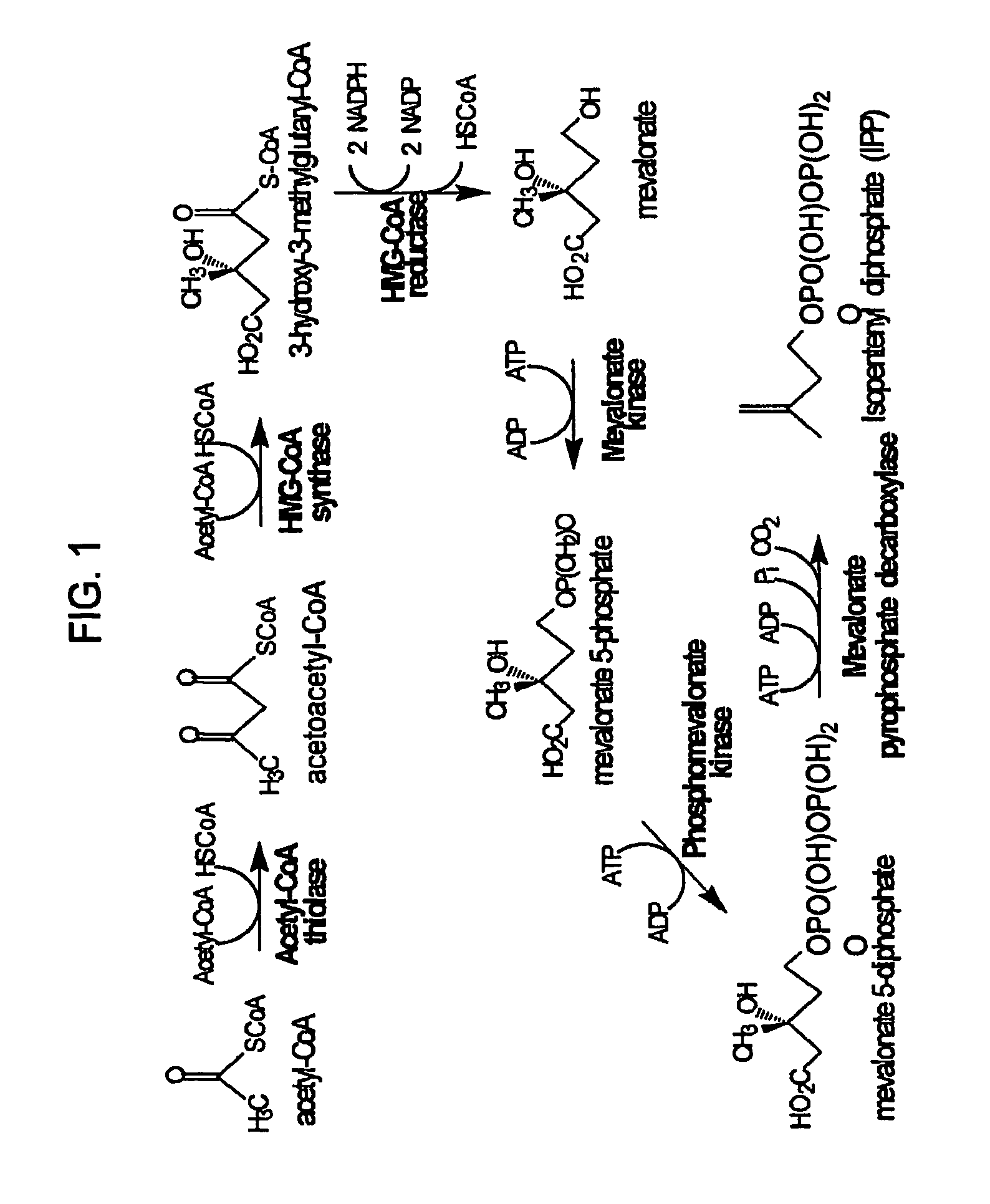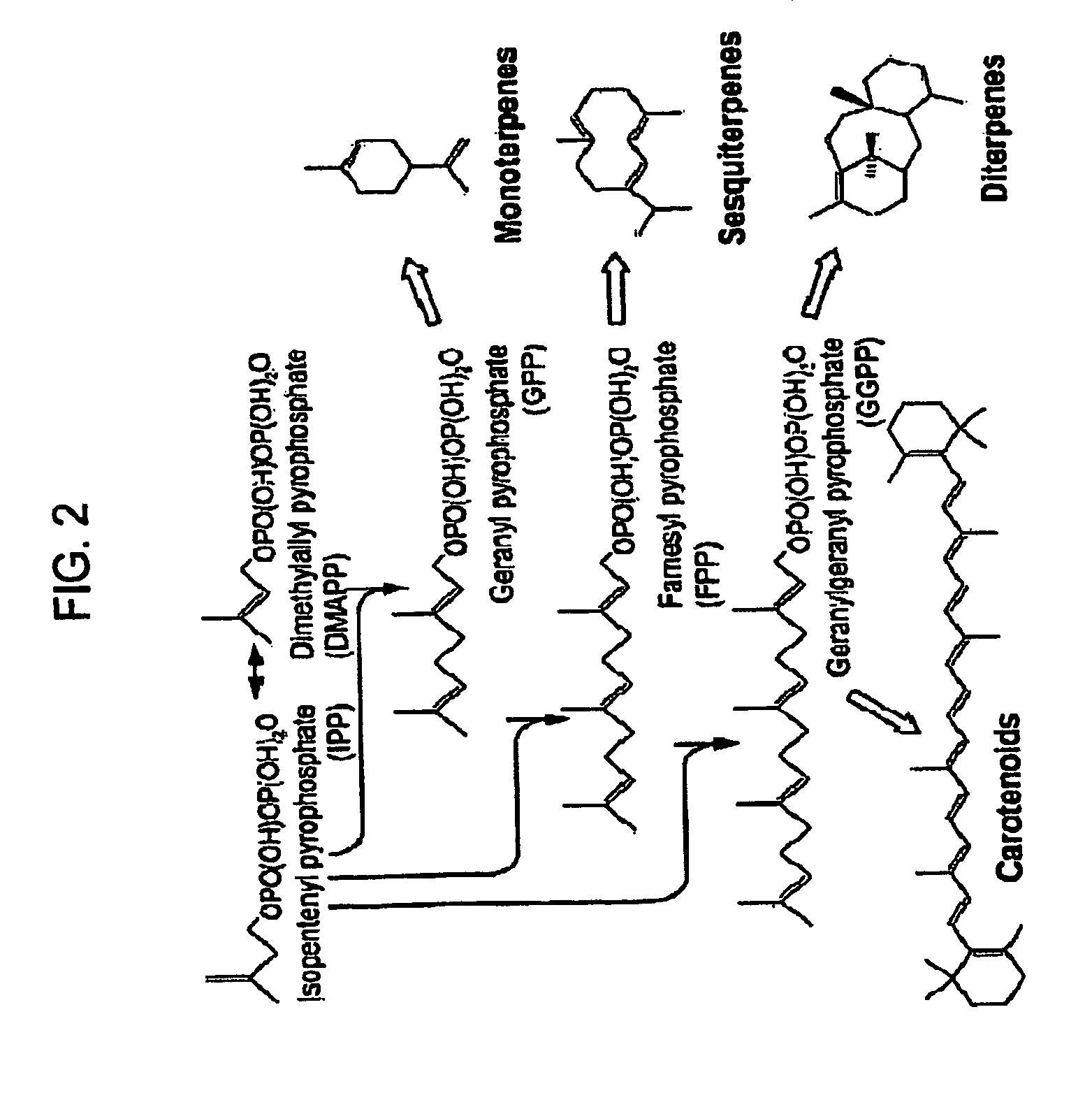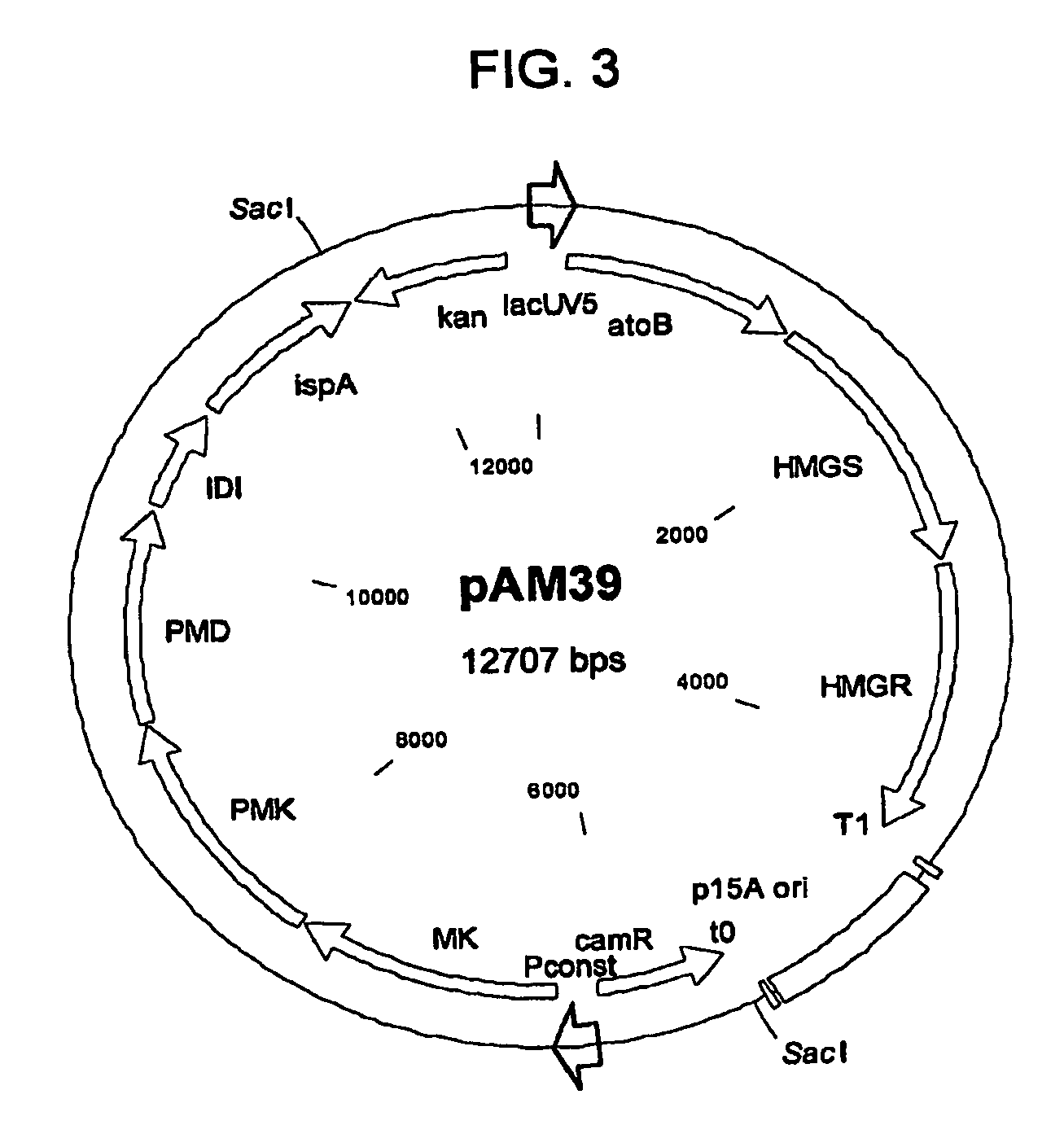Production of isoprenoids and isoprenoid precursors
a technology of isoprenoids and precursors, which is applied in the direction of lyase, transferase, microorganisms, etc., can solve the problems of inability to meet the needs of source organisms in general, low yield by extraction, and accumulation of most isoprenoids
- Summary
- Abstract
- Description
- Claims
- Application Information
AI Technical Summary
Benefits of technology
Problems solved by technology
Method used
Image
Examples
example 1
Generating Expression Plasmids Encoding Mevalonate Pathway Enzymes
[0139]Expression plasmid pMevT was generated by inserting the MevT operon into the pBAD33 vector. The MevT operon encodes the set of MEV pathway enzymes that together transform the ubiquitous precursor acetyl-CoA to (R)-mevalonate, namely acetoacetyl-CoA thiolase, HMG-CoA synthase, and HMG-CoA reductase. The MevT operon was generated by PCR amplifying from Escherichia coli genomic DNA the coding sequence of the atoB gene (GenBank accession number NC—000913 REGION: 2324131 . . . 2325315) (encodes an acetoacetyl-CoA thiolase), from Saccharomyces cerevisiae genomic DNA the coding sequence of the ERG13 gene (GenBank accession number X96617, REGION: 220 . . . 1695) (encodes a HMG-CoA synthase), and from Saccharomyces cerevisiae genomic DNA a segment of the coding region of the HMG1 gene (GenBank accession number M22002, REGION: 1660 . . . 3165) (encodes a truncated HMG-CoA reductase (tHMGR)). The upstream PCR primer used f...
example 2
Generation of Expression Plasmids that Encode Enzymes that Convert FPP
[0153]Expression plasmid pTrc99A-ADS was generated by inserting a nucleotide sequence encoding an amorpha-4,11-diene, synthase (“ADS”) into vector pTrc99A. The amorpha-4,11-diene synthase sequence was generated synthetically, so that upon translation the amino acid sequence would be identical to that described by Merke et al. (2000) Ach, Biochem. Biophys. 381:173-180, so that the nucleotide sequence encoding the amorpha-4,11-diene synthase was optimized for expression in Escherichia coli, and so that the nucleotide sequence was flanked by a 5′ NcoI and a 3′ XmaI restriction enzyme site (see U.S. Pat. No. 7,192,751). The nucleotide sequence was digested to completion using NcoI and XmaI restriction enzymes, the reaction mixture was resolved by gel electrophoresis, the approximately 1.6 kb DNA fragment was gel-extracted, and the isolated DNA fragment was inserted into the Ncol XmaI restriction enzyme site of the pTr...
example 3
Generation of Escherichia coli Host Strains
[0155]As detailed in Table 1, the host strains were created by transforming chemically competent Escherichia coli DH1 parent cells with one or more expression plasmids of Examples 1 and 2.
[0156]
TABLE 1Escherichia coli host strainsExpressionHost StrainPlasmidsAntibiotic SelectionB32pMevT100 ug / mL carbenicillinpMBIS35 ug / mL chloramphenicolpTrc-ADS10 ug / mL tetracyclineB59pAM39100 μg / ml carbenicillinpTrc-ADS35 μg / ml chloramphenicolB60pAM40pTrc-ADSB125pAM45pTrc-ADS1pMBIS100 μg / mL ampicillinpTrc-ADS50 μg / mL kanamycinpAM295 μg / mL tetracycline2pMBISpTrc-ADSpAM29-MK3pMBISpTrc-ADSpAM29-PMK4pMBISpTrc-ADSpAM29-MPD5pMBISpTrc-ADSpAM29-idi6pMBISpTrc-ADSpAM29-ispAB177pMevT100 μg / mL carbenicillinpMBIS35 μg / mL chloramphenicolpAM9410 μg / mL tetracycline
[0157]Host cell transformants were selected on Luria Bertoni (LB) agar containing antibiotics as detailed in Table 1. Single colonies of strains B59 and B60 were transferred from LB agar to culture tubes contain...
PUM
| Property | Measurement | Unit |
|---|---|---|
| temperature | aaaaa | aaaaa |
| temperature | aaaaa | aaaaa |
| temperature | aaaaa | aaaaa |
Abstract
Description
Claims
Application Information
 Login to View More
Login to View More - R&D
- Intellectual Property
- Life Sciences
- Materials
- Tech Scout
- Unparalleled Data Quality
- Higher Quality Content
- 60% Fewer Hallucinations
Browse by: Latest US Patents, China's latest patents, Technical Efficacy Thesaurus, Application Domain, Technology Topic, Popular Technical Reports.
© 2025 PatSnap. All rights reserved.Legal|Privacy policy|Modern Slavery Act Transparency Statement|Sitemap|About US| Contact US: help@patsnap.com



